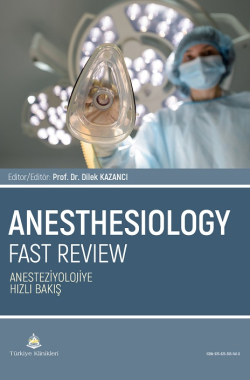NEUROMUSCULAR PHYSIOLOGY
Nuran Akıncı Ekinci
Konya City Hospital, Department of Anesthesiology and Reanimation, Konya, Türkiye
Akıncı Ekinci N. Neuromuscular Physiology. In: Kazancı D, editor. Anesthesiology Fast Review. 1st ed. Ankara: Türkiye Klinikleri; 2025. p.55-64.
ABSTRACT
- A thorough understanding of neuromuscular physiology is critical for the proper use of muscle relaxants inanesthesia, the management of neuromuscular diseases such as myasthenia gravis, and the treatment of certain poisonings.
- Neuromuscular transmission occurs through nicotinic acetylcholine (Ach) receptors, which are located on themuscle cell membrane and bound to the rapsin protein. These receptors are cylindrical complexes composed of five protein subunits. When Ach binds to the a subunits, ion channels open, allowing the entry of Na+ and Ca2+ ions and the exit of K+, initiating membrane depolarization.
- Muscle contraction begins with the formation of an action potential in the motor neuron, leading to the openingof voltage-gated Ca2+ channels and the release of Ach. Ach binds to postsynaptic receptors, causing Na+ entry and K+ exit, and once the threshold potential is reached, an action potential is generated in the muscle cell. This results in the release of Ca2+ from the sarcoplasmic reticulum (SR) and the interaction of actin and myosin, leading to muscle contraction. When depolarization ends, Ca2+ is reabsorbed by the SR, and muscle contraction ceases.
- Extrajunctional receptors increase in conditions such as burns, sepsis, and muscle inactivity, which canparticularly elevate the risk of hyperkalemia, especially with the use of succinylcholine.
- Local anesthetics, ketamine, and inhaled anesthetics are among other agents that affect neuromusculartransmission. These agents create neuromuscular block by altering the opening and closing dynamics of ion channels, without directly interacting with the acetylcholine binding site.
- Neuromuscular monitoring is used to evaluate neuromuscular transmission by applying electrical stimulation toa peripheral motor nerve. The presence and degree of neuromuscular blockade are determined by the reduction in muscle response.
Keywords: Neuromuscular junction; Receptors, cholinergic; Neuromuscular monitoring; Neuromuscular blockade
×
Kaynak Göster
Referanslar
- Guyton AC, Hall JE. Excitation of skeletal muscle: Neuromuscular transmission and excitation-contraction coupling. In R. Gruliow (Ed.), Medical Physiology 2006;11:85-91. Philadelphia: Elsevier Saunders. [Link]
- Martyn JAJ, Fagerlund MJ, Eriksson LI. Basic principles of neuromuscular transmission. Anaesthesia. 2009;64(1):1-9. [Crossref] [PubMed]
- Kelly RB. The cell biology of the nerve terminal. Neuron. 1988;1(6):431-438. [Crossref] [PubMed]
- Lang B, Wray D, Newsom-Davis J, Vincent A, Murray N. Autoimmune aetiology for myasthenic (Eaton-Lambert) syndrome. The Lancet. 1981;318(8240):224-226. [Crossref] [PubMed]
- Wessler I, Kirkpatrick C. Acetylcholine beyond neurons: the non-neuronal cholinergic system in humans. British Journal of Pharmacology. 2008;154(8):1558-1571. [Crossref] [PubMed] [PMC]
- Miledi R, Molenaar PC, Polak RL. Electrophysiological and chemical determination of acetylcholine release at the frog neuromuscular junction. The Journal of Physiology. 1983;334:245-254. [Crossref] [PubMed] [PMC]
- Wang X, Engisch KL, Li Y, Pinter MJ, Cope TC, Rich MM. Decreased synaptic activity shifts the calcium dependence of release at the mammalian neuromuscular junction in vivo. The Journal of Neuroscience. 2004;24(47):10687-10692. [Crossref] [PubMed] [PMC]
- Aroniadou-Anderjaska V, Figueiredo TH, de Araujo Furtado, M, Pidoplichko VI, Braga MF. Mechanisms of organophosphate toxicity and the role of acetylcholinesterase inhibition. Toxics. 2023;11(10):866. [Crossref] [PubMed] [PMC]
- Catterall WA, Lenaeus MJ, Gamal El-Din TM. Structure and pharmacology of voltagegated sodium and calcium channels. Annual Review of Pharmacology and Toxicology. 2020;60(1):133-154. [Crossref] [PubMed]
- Köşker AR, Özoğul F, Ayas D, Durmuş M, Uçar Y. Akdeniz'in yeni toksini: Tetrodotoksin. The New Toxin of Mediterranean: Tetrodotoxin. 2015;32(1):15-24. [Crossref]
- Miller GA, Gronert GA. Pathophysiology of hyperkalemia induced by succinylcholine. Anesthesiology. 1975;43:89-99. [Crossref]
- Morris J, Cook TM. Rapid sequence induction: A national survey of practice. Anaesthesia. 2001;56(11):1090-1097. [Crossref] [PubMed]
- Morgan GE, Mikhail MS, Murray MJ. Neuromuscular blocking agents. In Clinical Anesthesiology 2002:175-200 USA: McGraw-Hill.
- Miller, R. D. (2011). 12 Neuromuscularblockıngdrugs. Basics of Anesthesia E-Book, 143. [Crossref]
- Kopman AF. Managing neuromuscular block: Where are the guidelines? Anesthesia & Analgesia. 2010;111(1): 9-10. [Crossref] [PubMed]
- Kopman AF, Brull SJ. Current status of neuromuscular reversal and monitoring: Challenges and opportunities. Anesthesiology. 2017;126:173-190. [Crossref]
- Viby-Mogensen J. Neuromuscular monitoring. In R. D. Miller (Ed.), Miller's Anesthesia 2010;7:1515-1531. Philadelphia: Churchill Livingstone. [Crossref]
- Claudius C, Garvey LH, Viby-Mogensen J. The undesirable effects of neuromuscular blocking drugs. Anaesthesia. 2009;64(1):10-21. [Crossref] [PubMed]
- Donati F, Bevan DR. Neuromuscular blocking agents. In PG Barash, BF Cullen, RK Stoelting (Eds.), Clinical Anesthesia 2006;5:421-452. Philadelphia: Lippincott Williams & Wilkins. [Link]
- Mogensen JV, Jensen E, Werner M, Nielsen, HK. Measurement of acceleration: A new method of monitoring neuromuscular function. Acta Anaesthesiologica Scandinavica, 1988;32(1):45-48. [Crossref] [PubMed]
- Trager G, Michaud G, Deschamps S, Hemmerling TM. Comparison of phonomyography, kinemyography and mechanomyography for neuromuscular monitoring. Canadian Journal of Anesthesia. 2006;53(2):130-135. [Crossref]

